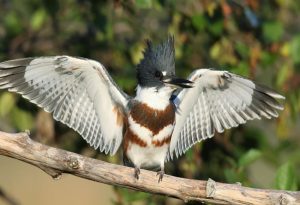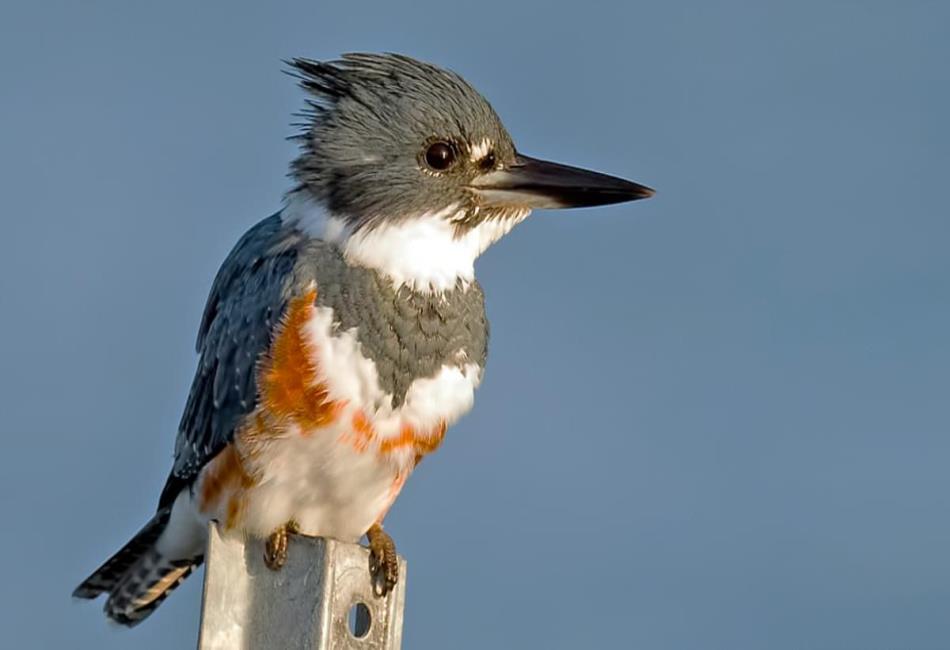Belted Kingfisher: A Striking and Skilled Fisher of North America
The belted kingfisher (Megaceryle alcyon) is a fascinating and distinctive bird that graces the waterways of North America. Known for its loud, rattling call and striking plumage, this bird is an expert angler and a charismatic symbol of riparian habitats. With its ability to dive with precision and adapt to various environments, the belted kingfisher is a bird of remarkable skill and beauty.
Physical Description
The belted kingfisher is a medium-sized bird, easily recognizable by its unique features:
- Size: Adults measure about 11 to 14 inches in length, with a wingspan of 19 to 23 inches.
- Plumage: Both males and females display a slate-blue head, back, and wings, with a prominent white belly. Females have an additional chestnut-colored band across their belly, making them one of the few bird species where females are more colorful than males.
- Crest: A shaggy crest atop their heads gives them a distinctive silhouette.
- Bill: Their long, sharp beak is perfectly adapted for catching fish, their primary food source.
Habitat and Range
The belted kingfisher is found across a wide range of habitats in North America. They prefer areas near water, such as:
- Rivers
- Lakes
- Streams
- Ponds
- Coastal shorelines
These birds are highly territorial and are often seen perched on branches, wires, or rocks near water, where they survey the surface for prey. In winter, some individuals migrate to Central America or the southern United States, while others remain in their breeding range if open water is available.

Behavior and Diet
The belted kingfisher is a master hunter, relying on its keen eyesight and agile diving skills to catch its prey.
- Diet: The primary diet of the belted kingfisher consists of small fish, but they also consume amphibians, crustaceans, insects, and occasionally small mammals or birds.
- Hunting Style: Perched above the water, the bird waits patiently for prey to swim near the surface. Once spotted, it dives headfirst into the water with incredible precision, using its strong beak to snatch its meal.
- Feeding Techniques: After catching a fish, the kingfisher typically returns to its perch to beat the prey against a branch, ensuring it is stunned or dead before swallowing it whole.
Breeding and Nesting
The belted kingfisher’s nesting habits are as unique as its hunting style.
- Mating Season: Breeding occurs from April to July. During courtship, males often offer fish to females as part of their mating ritual.
- Nesting: Unlike most birds, belted kingfishers dig burrows into sandy or muddy banks near water. Using their strong legs and sharp claws, they excavate tunnels that can extend 3 to 6 feet deep, ending in a nesting chamber.
- Eggs: Females lay 5 to 8 white eggs, which both parents incubate for about three weeks. Once the chicks hatch, both parents share the responsibility of feeding and protecting them until they fledge after approximately four weeks.
Vocalizations
One of the most notable features of the belted kingfisher is its loud, distinctive call. The bird’s rattling cry is often heard before it is seen, echoing over rivers and lakes. These vocalizations are used for communication, territorial defense, and courtship.
Adaptations for Survival
The belted kingfisher has evolved several remarkable adaptations that make it an efficient predator and resilient bird:
- Vision:
- Its eyesight is well-suited for spotting prey under water, with the ability to compensate for refraction caused by the water’s surface.
- A third eyelid, called a nictitating membrane, protects the bird’s eyes during dives.
- Streamlined Body:
- Its compact, muscular body is built for plunging into water with minimal resistance.
- Sharp Beak:
- The long, pointed beak acts like a spear, allowing the bird to capture slippery prey efficiently.
- Burrowing Ability:
- By nesting in burrows, the kingfisher avoids many predators that might raid open nests in trees or shrubs.
Threats and Conservation
Despite their adaptability, belted kingfishers face several threats in the wild:
- Habitat Loss: Urbanization, deforestation, and pollution of waterways can reduce suitable habitats and nesting sites.
- Climate Change: Rising temperatures and altered precipitation patterns can impact water quality and fish populations, affecting the kingfisher’s food supply.
- Human Disturbance: Recreational activities near water bodies can disrupt breeding and feeding behaviors.
Conservation efforts focus on preserving and restoring riparian habitats, protecting nesting sites, and ensuring clean waterways. The belted kingfisher is currently classified as a species of “Least Concern” by the International Union for Conservation of Nature (IUCN), but ongoing conservation is essential to maintain stable populations.
Symbolism and Cultural Significance
The belted kingfisher has been a source of inspiration in art, literature, and folklore across various cultures:
- Native American Folklore: In some tribes, the kingfisher is considered a messenger and a symbol of determination and patience.
- Art and Literature: The bird’s striking appearance and behavior have made it a popular subject for wildlife artists and writers.
- Symbolism: Across many cultures, the kingfisher is associated with prosperity, peace, and sharp instincts.
Watching Belted Kingfishers
For birdwatchers and nature enthusiasts, spotting a belted kingfisher can be a thrilling experience. To increase your chances:
- Look for them near bodies of water, perched on exposed branches or utility wires.
- Listen for their distinctive rattling call, which often announces their presence.
- Use binoculars to observe their fishing dives and burrowing activities from a respectful distance.
Conclusion
The belted kingfisher is a remarkable bird that embodies resilience, adaptability, and skill. Its unique behaviors, striking appearance, and important role in aquatic ecosystems make it a beloved species among birdwatchers and conservationists alike. Protecting the habitats of the belted kingfisher ensures not only the survival of this fascinating bird but also the health of the waterways they call home. Whether admired for its hunting prowess or its cultural significance, the belted kingfisher continues to capture the imagination of those who encounter it in the wild.



![Great Hornbill [Buceros bicornis]: Discovering its World](https://birdzpedia.com/wp-content/uploads/2023/12/Great-Hornbill-768x402.png)
![Toco Toucan[: Ramphastos toco] Overview, Habitat, Diet, Sounds](https://birdzpedia.com/wp-content/uploads/2023/12/Toco-Openbill-768x402.png)


